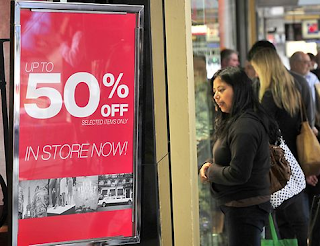March Madness for Consumers
 The close to last week offered up a sour tasting consumer report, and given the slew of related data produced through week, we thought we would take a look at the state of the American consumer today. The latest reporting of consumer confidence put a dent into the roaring market’s rise, with the SPDR Dow Jones Industrials Average ETF (NYSE: DIA) looking tired Friday. What I see in store for retail and the consumer discretionary sector is not as savory as the profits logged year-to-date therein.
The close to last week offered up a sour tasting consumer report, and given the slew of related data produced through week, we thought we would take a look at the state of the American consumer today. The latest reporting of consumer confidence put a dent into the roaring market’s rise, with the SPDR Dow Jones Industrials Average ETF (NYSE: DIA) looking tired Friday. What I see in store for retail and the consumer discretionary sector is not as savory as the profits logged year-to-date therein. Our founder earned clients a 23% average annual return over five years as a stock analyst on Wall Street. "The Greek" has written for institutional newsletters, Businessweek, Real Money, Seeking Alpha and others, while also appearing across TV and radio. While writing for Wall Street Greek, Mr. Kaminis presciently warned of the financial crisis.
Our founder earned clients a 23% average annual return over five years as a stock analyst on Wall Street. "The Greek" has written for institutional newsletters, Businessweek, Real Money, Seeking Alpha and others, while also appearing across TV and radio. While writing for Wall Street Greek, Mr. Kaminis presciently warned of the financial crisis.March Madness
On the week, we received at least five consumer relevant economic reports, including the Reuters/University of Michigan Consumer Sentiment Index, Retail Sales, Consumer Price Index, Bloomberg Consumer Comfort Index and the ICSC –Goldman Store Sales data. None of it really stymied the market’s rise through the week, with the SPDR S&P 500 Index ETF (NYSE: SPY) gaining 2% through Friday’s close. In fact, I suspect Friday’s reported Consumer Sentiment Index slippage was only partially responsible for the market’s intraday reconsideration of the week’s stock gains; though what’s behind the new consumer view played a major role.
Consumer Sentiment fell by a point, according to the Reuters/University of Michigan survey. The index declined to 74.3, from February’s 75.3, setting early stock action at odds with the week’s trend. The key driver of the slip was inflation expectations, which pulled down the overall expectations component. Rising gasoline prices have consumers worried about how the critical cost might eat into their lifestyles. But, as of now, consumers don’t yet see gasoline prices sticky. When that happens, you have a real problem for this consumer driven economy.
Just a day earlier, the Bloomberg Consumer Comfort Index offered a different perspective. Bloomberg’s weekly measurement of the consumer mood improved to -33.7, from -36.7 the week before. The driver of this change was of course the latest labor market gains, as seen in the nonfarm payroll rise in the Employment Situation Report and in the latest week’s Jobless Claims dive to a four-year low mark.
So just how important have gasoline prices been given the divergence in these two metrics. Clearly, they have been more important over the course of the month than the week. The Consumer Price Index was just reported for February Friday. It showed a 0.4% increase in prices, largely on gasoline (+6%) and overall energy price increase (+3.2%). Excluding food and energy, the Core CPI only edged 0.1% higher, which was less than expected (+0.2%) and less than January’s 0.2% gain. However, if petroleum remains elevated for long enough, the impact could seep into the cost of goods eventually. Granted, “long enough” is probably longer than the world will wait for Iran to comply. Thus, I think you can count on inflation, because war with Iran would only compound on the pressure weighing on petroleum prices.
The latest indicators of consumer spending included two reports published this past week. The International Council of Shopping Centers (ICSC) produced another soft result. The ICSC report showed week-over-week sales growth at 0.7%, with the year-to-year change at just 2.3%. The latest crisis at J.C. Penney (NYSE: JCP) and Sears (Nasdaq: SHLD) offers evidence that capacity remains extended, and there will be winners and losers competing for limited consumer funds.
Retail Sales were reported for February earlier this week, rising 1.1%, a swifter pace than January’s 0.4% gain. Hold your horses though, because gas station sales added a bunch to taint tangible growth. Excluding autos, sales were up 0.9%, and when taking out gasoline and autos, growth managed just 0.6%. That was in line with the economists’ consensus and matched January’s pace. The growth was still impressive to some of us who have been looking for a consumer sector slide. Bite your tongue before berating me for that view, though, because the economic trial I’ve been looking towards appears to be developing.
Investors in the consumer and retail sectors should be happy enough so far this year, with the SPDR Select Sector Fund – Consumer Discretionary (NYSE: XLY) and the SPDR S&P Retail ETF (NYSE: XRT) up roughly 14% and 16%, respectively, through March 16. Yet, I reiterate and renew my warning. Beware the ides of March, for they bring European economic struggle and higher gasoline and energy prices. I expect your labor market support to crack soon enough as a result. I reported recently on the undermining I anticipate for still unsure small business confidence. Much of that should have catalyst in crushed consumer confidence. In conclusion, I remain concerned about the vulnerable economy given the weights upon it and the risks against it.
Article interests investors in: S&P Retail ETF (NYSE: XRT), Wal-Mart (NYSE: WMT), Pier 1 Imports (NYSE: PIR), Ethan Allen (NYSE: ETH), Hooker Furniture (Nasdaq: HOFT), Home Depot (NYSE: HD), Lowes (NYSE: LOW), Apple (Nasdaq: AAPL), Best Buy (NYSE: BBY), The Limited (NYSE: LTD), Chicos (NYSE: CHS), Ann Taylor (NYSE: ANN), The Gap (NYSE: GPS), Macy’s (NYSE: M), JC Penney (NYSE: JCP), Nordstrom (NYSE: JWN), TJX Company (NYSE: TJX), Kohls (NYSE: KSS), Costco (Nasdaq: COST), Target (NYSE: TGT), Wet Seal (Nasdaq: WTSLA), Hot Topic (Nasdaq: HOTT), American Eagle Outfitters (NYSE: AEO), Aeropostale (NYSE: ARO), Abercrombie & Fitch (NYSE: ANF), Saks (NYSE: SAK), Tiffany (NYSE: TIF), Talbots (NYSE: TLB), Lumber Liquidators (NYSE: LL), Builders Firstsource (Nasdaq: BLDR), Fortune Brands (NYSE: FO), Leggett & Platt (NYSE: LEG), Tempur-Pedic International (NYSE: TPX), Acuity Brands (NYSE: AYI), La-Z-Boy (NYSE: LZB), Select Comfort (Nasdaq: SCSS), Sleepy’s (NYSE: ZZ), Furniture Brands (NYSE: FBN), Natuzzi (NYSE: NTZ), Sears (Nasdaq: SHLD), Dillard’s (NYSE: DDS), Bon-Ton (Nasdaq: BONT), Cost Plus (Nasdaq: CPWM), Baker’s Footwear (Nasdaq: BKRS.OB), Bebe Stores (Nasdaq: BEBE), The Buckle (NYSE: BKE), Cache (Nasdaq: CACH), Casual Male (Nasdaq: CMRG), Cato (Nasdaq: CATO), Christopher & Banks (NYSE: CBK), Citi Trends (Nasdaq: CTRN), Collective Brands (NYSE: PSS), Destination Maternity (Nasdaq: DEST), Dress Barn (Nasdaq: DBRN), DSW (NYSE: DSW), Finish Line (Nasdaq: FINL), Footlocker (NYSE: FL), Gymboree (Nasdaq: GYMB), Guess (NYSE: GES), J. Crew (NYSE: JCG), Jones New York (NYSE: JNY), Jos. A Banks (Nasdaq: JOSB), New York & Co. (NYSE: NWY), Men’s Wearhouse (NYSE: MW), Syms (Nasdaq: SYMS), The Children’s Place (Nasdaq: PLCE).
Please see our disclosures at the Wall Street Greek website and author bio pages found there. This article and website in no way offers or represents financial or investment advice. Information is provided for entertainment purposes only.

Labels: consumers, Consumers-2012-Q1, Economic-Reports, Economic-Reports-2012-03, Economy, Economy-2012-03, INDUSTRY-Retail-Stores, SECTOR-Consumer-Goods











0 Comments:
Post a Comment
<< Home